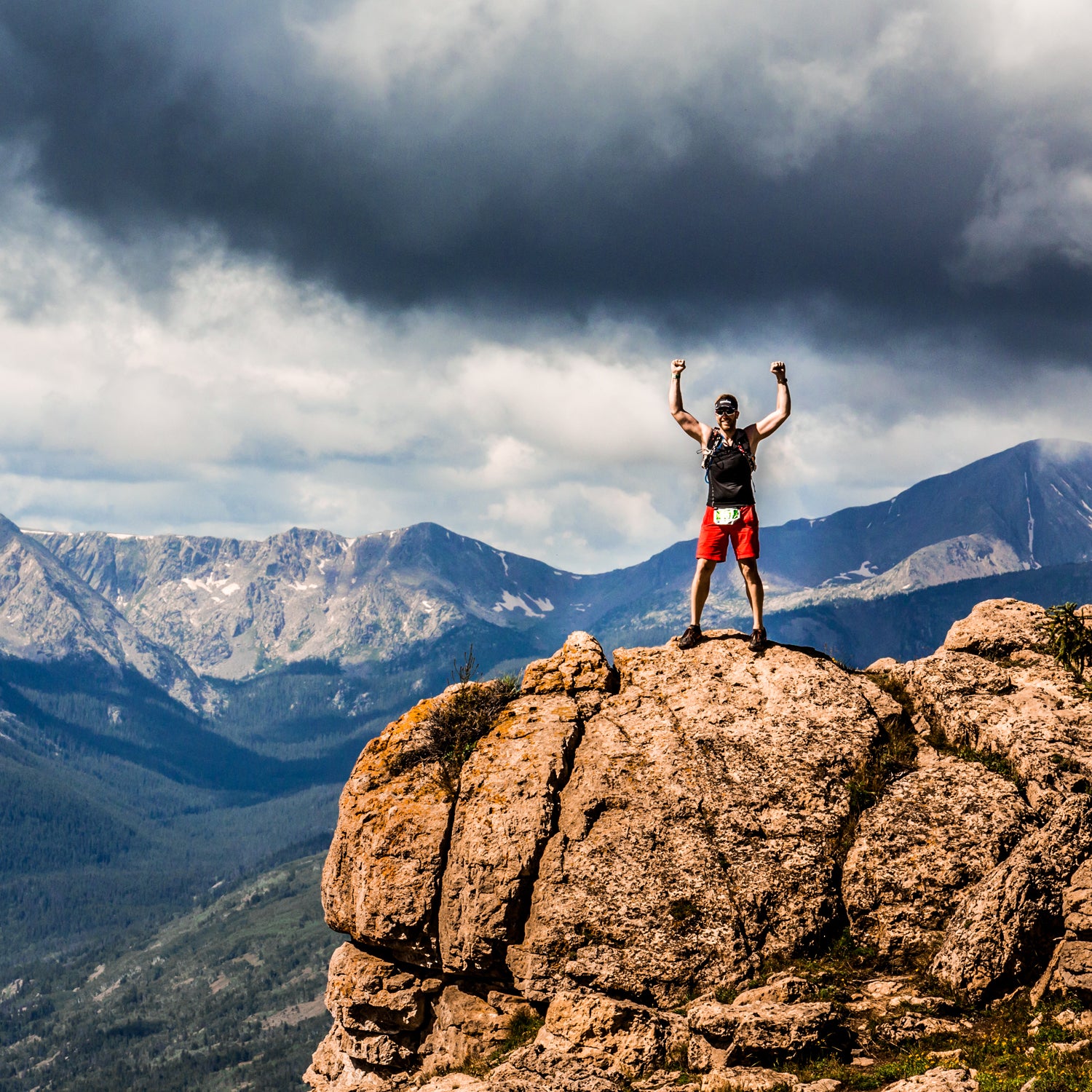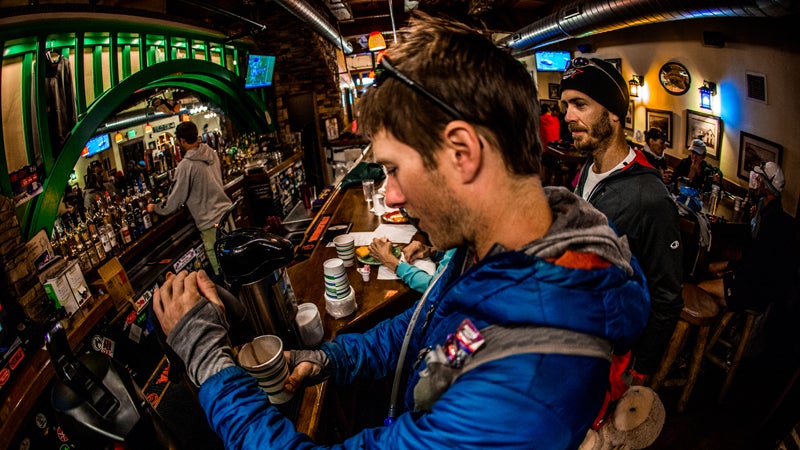Last month, 400 runners from all over the world converged in Colorado for the start of the TransRockies Trail Run, a three- or six-day stage race over the mountains from Buena Vista to Vail. The course spans 120 miles and gains nearly 20,000 feet of vertical, much of it above 10,000 feet.
Since its launch in 2005, the TransRockies has been part competitive proving ground (reigning Western States and Leadville champ Rob Krar won the TransRockies three times) and part jovial communal backcountry adventure, attracting athletes of all abilities. Some come for an adrenaline-charged summer vacation with friends and family, others (like me) for a high-altitude training camp to prep for fall ultras. And some, like a 46-year-old father of four from L.A. named Frank, who started running eight months ago and has since lost 150 pounds, use the race as a—gulp—total-immersion intro to trail running.
In stage racing, the mileages are shorter than traditional one-day ultra marathons—at the TransRockies, we covered 14 to 24 miles per day—but the wear and tear on your body and psyche is just as, if not more, intense. Knowing you have to run hard and then get up day after day and do it again requires as much mental stamina as physical endurance. All of which make stage races ideal opportunities for dialing in your racing and recovery strategies. Think of them as intensive endurance labs: You have to run smart, but recover smarter. Be lazy about your maintenance and you'll burn up the next day. Unlike most ultra races, the real work begins after you cross the finish line.
Here are ten secrets I picked up while racing, and winning, the three-day, 58-mile TransRockies Run. No matter what level of runner you are—elite, middle-of-the-pack, or noob—you can apply these tips to stage racing, ultra marathons, mountain running, back-to-back long runs, and everyday training to become a stronger runner—mentally and physically.
1. It's All About Management
When you're running several days in a row, you need to keep your body as fresh as possible from start to finish. You should be eating and hydrating while running and resting. When you're not running, you should be prepping your gear and working out any kinks in your system—in your body or otherwise. You'll need to be vigilant and pay attention to the details: Are you hungry? Are you dehydrated? How often are you peeing? What hurts? Have you organized your kit for the next morning? (Advance prep is just as essential when you need to get out the door early for a long weekend training run.) There's not a lot of downtime. Go in ready to deal with the details and you'll make it to the finish, maybe even running faster than when you started.
2. Stretch ASAP
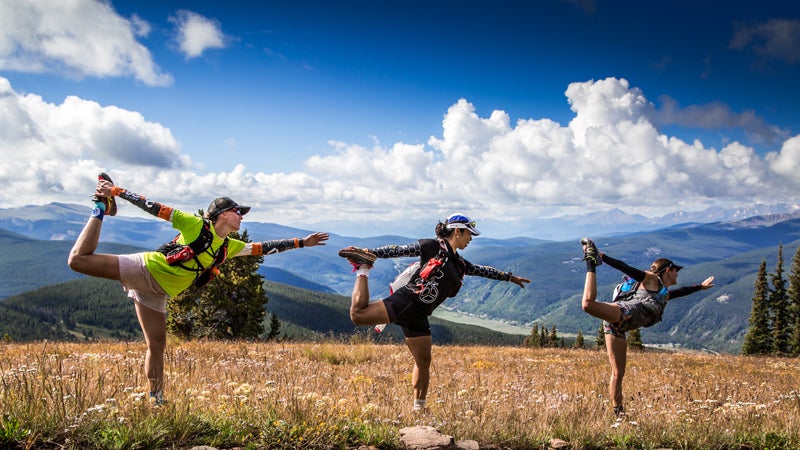
There's a natural temptation when you finish a race to collapse on the ground and bask in your own private glory. This is a bad idea. Research shows that stretching after exercise is more effective than before a workout, when your muscles are cold (and when it can reduce performance). To prevent my Achilles and calves from becoming piano-wire tight after mountain runs, I've developed a simple, five-minute routine of four or five basic running stretches to elongate my hamstring, calves, quads—a leg-saver after running the 21-mile stage one in just over three hours. When I make time to do this sequence within 10 minutes of finishing a run, I reduce my next-day stiffness considerably. When I forget, I feel it. Whatever's in your personal arsenal of post-run mobility exercises, don't neglect them on race day. They're what will get you out of bed (or off the ground) and out the door the next morning.
3. Refuel Right Away
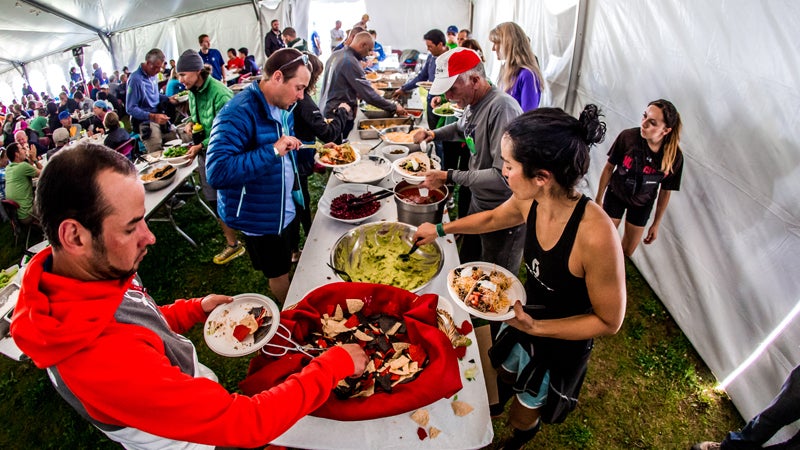
For years the conventional wisdom about recovery nutrition was that you need to consume food with a ratio of carbs to protein within an hour of finishing a race or a hard workout. New studies, though, are challenging the urgency of this recovery window, suggesting we may have longer than we think to refuel our bodies and aid our muscles' recovery. Even if you don't technically need to slam a drink or a PBJ the second you cross the finish line or conclude a training run, doing so within the first hour helps keep you on track and reminds you to eat, which can be tricky when you're in the middle of nowhere, caught up in the excitement of the finish line. A deli sandwich, peanut butter and jelly, or a protein-boost smoothie will do the trick, but a powdered beverage is often handier on the go and easier to digest than food. Pro runner and 2014 three-day men's champion Matt Hart swears by Ultragen, a powdered cappuccino-flavored recovery drink with 320 calories per serving and all the requisite nutrition (minus the caffeine). And after the first stage, when he filled my bottle with two heaping scoops which I slugged down in record time, I swore by it, too.
4. Soak and Freeze Your Bones
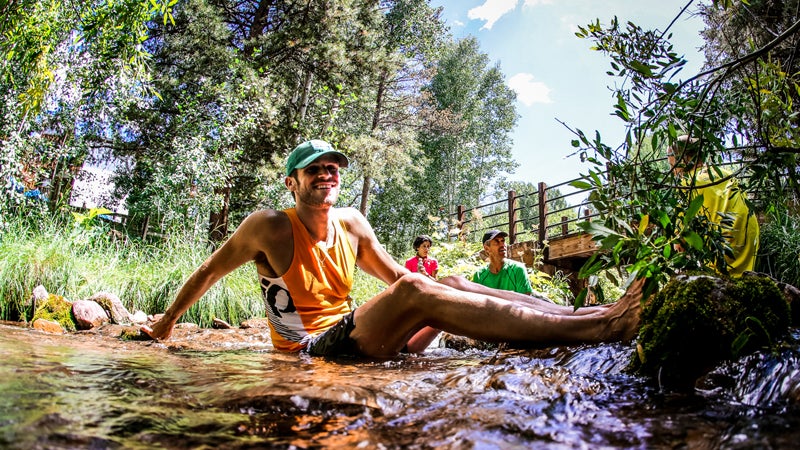
The merits of icing for injury may be debatable, but there's no question that immersing yourself in cold water right after a hard effort offers sweet, cheap, immediate relief for sore muscles. Female 50K national champion Emily Harrison, who won the TransRockies six-day mixed team race with her partner Ian Torrence, preaches the benefits of ice baths during peak training and racing to refresh your legs for the next hard run. Daily, post-race soaking was the cornerstone of my TransRockies survival strategy; it also became a group ritual. I waded into the frigid Arkansas River with Emily and dozens of other runners after stage one, crouched in a semi-murky, foot-deep irrigation ditch back at camp, dove headfirst into a cold pond at Twin Lakes, and sat in waist deep water at the edge of a fishing pond after stage three. When I got out after ten minutes, or 20 if I could stand it, my legs no longer felt stiff or sore. They were so numb, I couldn't feel them period. Don't be too choosy: Submerge as soon as you can in whatever you can find.
5. Get a Little Loose
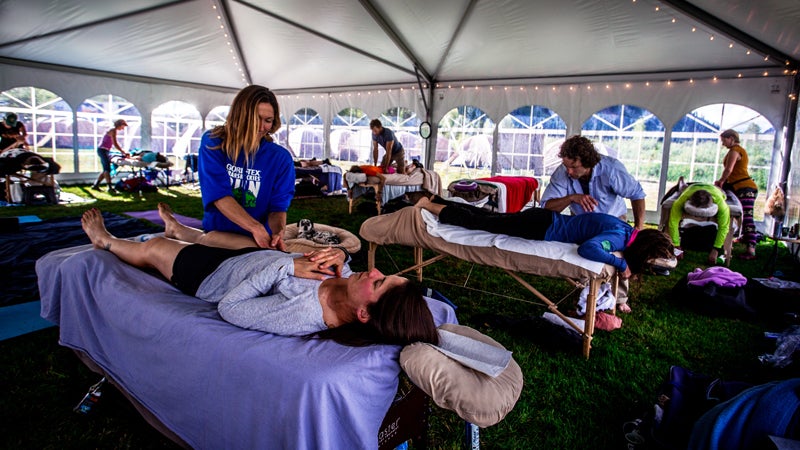
The massage tent was the second most popular place in camp, after the “relaxation station,” with free M&Ms and, somewhat dubiously, a bottomless stash of Michelob (PepsiCo was the TransRockies' title sponsor). I managed to snag a 15-minute, $20 treatment each afternoon from a Thai-massage expert named Todd who contorted my body in weird, somewhat terrifying ways, but always left me feeling more limber than when I lurched in. Bottom line: post-race massage, even if it's just a few minutes, works wonders. If you can't get professional help, be sure to BYO mobility tools, like the small and super portable Stick Traveler Roller Massager, a half foam roller, and a simple lacrosse ball. Each evening, I spent ten minutes rolling out my Achilles, calves, quads, and IT bands and each morning before heading to the starting line, whipped through a DIY yoga sequence in my tent.
6. Nap Every Single Day
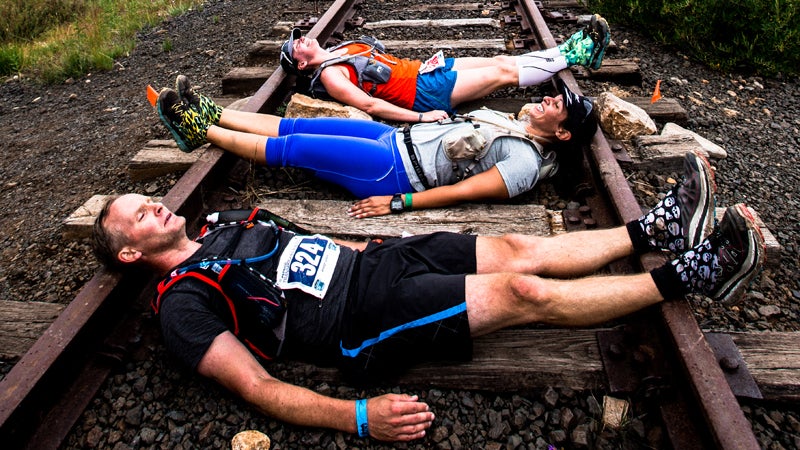
In a nonstop, high energy event like the TransRockies, making time to rest takes effort, but seasoned pros like Magdalena Boulet, who won the six-day women's team race with her partner, Caitlynn Smith, chased every stage with a nap. After stage two—14 miles up and over 12,500-foot Hope Pass—I crawled into my tent in the Leadville High School baseball field and sprawled out with my book. I'm not sure I actually dozed off, but lounging on my sleeping bag in the quiet grey afternoon was a rare treat and R&R my body and brain desperately needed to reboot. Same goes for an early bedtime. For a camp with 400+ wall-to-wall tents, it was freakishly silent after 9 p.m. Even if you're training, not racing, grabbing extra zzzs when you can aids muscle recovery, reduces stress, and gives you a mental and physical boost for your next big effort.
7. Eat Early and Often
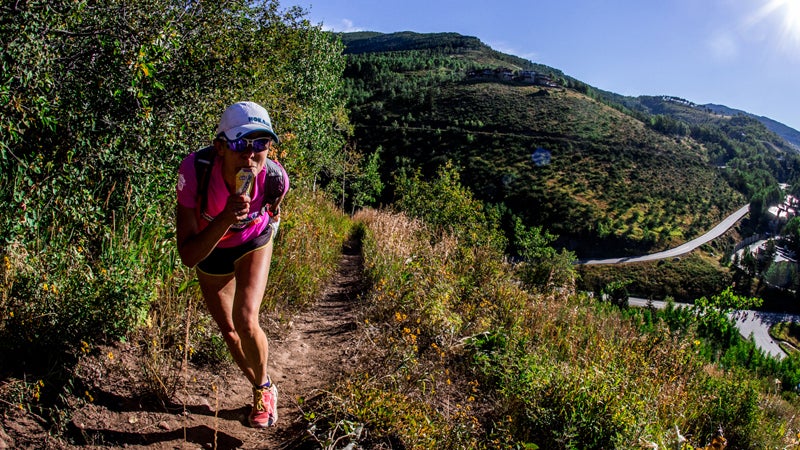
One of the toughest tests of mental stamina for me during the TransRockies was eating. I've trained myself to take in the recommended 100 calories about every 30 minutes when I race—mostly easily digestible electrolyte gels and chews like Gu or Clif Blocks. (It's an inexact science. I don't wear a watch, so whenever I think about eating, I eat. Same goes for hydrating with Nuun tablets.) The key is to eat before you feel hungry and drink before you're thirsty, otherwise you'll find yourself in a very deep hole from which it's difficult to dig out. But during the TransRockies' fast, short-ish stages, I could feel my body burning through the fuel—by some estimates, ultra runners expend 1,000 calories an hour—and I knew I needed to recoup all that lost energy afterwards in order to keep running strong.
One afternoon in Leadville, desperate for calories, I broke my dairy and gluten boycott and ordered a small pizza from High Mountain Pies on Fourth Street and ate almost the whole thing by myself before a couple of runners came along looking hungry and I gave them the last two slices. What I did in the communal mess tent twice a day felt less like dining and more like force-feeding: second helpings of beets and greens, salad heaped with beans and nuts, brown rice, and any protein I could get my hands on. Over breakfast one morning, Canadian ultrarunner Ian MacNairn whipped out his private stash of BYO instant oatmeal from Alberta-based Stoked Oats, which spikes its porridge with instant coffee. Buzzz….When you're going the distance for days on end—whether racing or training—quantity counts as much as quality.
8. Make Prevention Your Best Friend

During a long race, or consecutive races, any nagging issue has the potential to become monumental if you don't deal with it right away, or better yet, prevent it from happening in the first place. At the TransRockies, this meant inventing and abiding by a lengthy pre- and post-race routine involving many lubes and pills (all legal). My masseuse in Santa Fe recommended I slather my legs in oil before and after each run. (“Katie,” he intoned in a deep voice from beyond, “your body is speaking to me.”) Obediently, I greased up with sandalwood oil and then double-lubed my calves and quads with Traumeel, a homeopathic Arnica gel that's my go-to fix for sore muscles. Last on was the Body Glide anti-chafe ointment which Ian MacNairn forgot to use on day three, staggering into the finish line with thighs so shredded he could barely walk. (I gave him my tube of miracle, food-grade Climb On cream, which healed him so quickly he went on to take second overall in the men's six-day solo race.) Each morning, I popped Vitamin B complex with 1,000 mg of C to boost my immune system, a handful of fish oil capsules, and a few Turmeric capsules to reduce inflammation. (Advil was a last resort.) Next to the yoga tent, the Vail-based Steadman Medical Clinic kiosk did a brisk business every morning, taping people's sore muscles, hot spots, and blisters and heading off disaster before it struck. Slack off on your system, whatever it is, and you will regret it.
9. Embrace the Competition
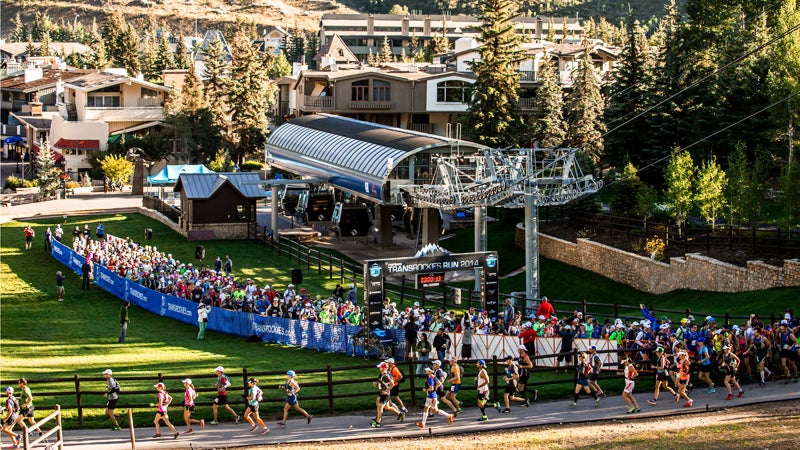
I've always had a complicated relationship with competition. I love to run for the sheer, simple joy of being out on the trails, deep in nature. But when I race, I want to win, and all the drive and stress of race day can take the fun out of running. Which made my decision to sign up for the TransRockies three-day race a little, well, odd. It wasn't one race, but three, all in a row. And because I was camping with the rest of the runners, I was running, eating, drinking, sleeping, and living in the race. As it turns out, going all in was just what I needed to take the edge off racing. By day two, the pre-start lineup at the PortaPotties no longer phased me, nor did the countdown to go. Sure I still felt a few jitters, but most of my ambivalence and fear were gone. This was simply what we did. Three days at the TransRockies had strengthened my competitive mindset and shored up my mental stamina. In this way, the race itself was training.
10. Always Have Fun
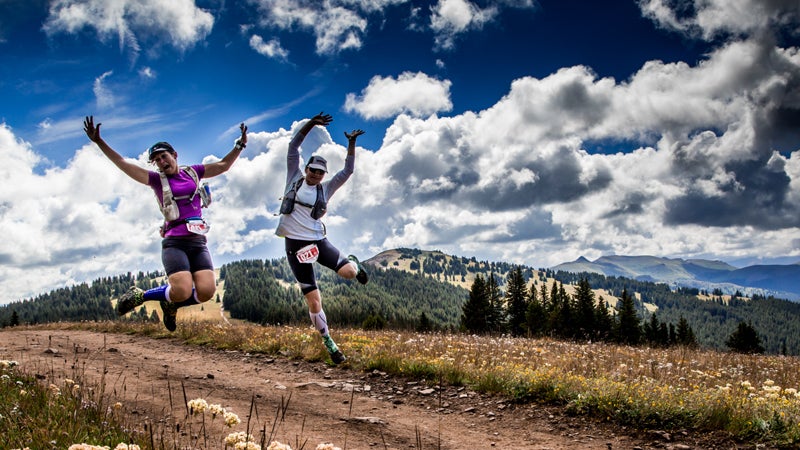
Once you've tended carefully to the above, you're free to relax and have fun or run your tail off and try to win. Better yet, both. I didn't know anything about stage racing before the TransRockies, and hadn't given my strategy much thought, except that I figured I ought to go out easy the first day and save my legs for later stages. Ha. As soon as the speakers started blaring “Highway to Hell” and hundreds of runners began pressing into the start corral on day one, I could feel my competitive fire start to flare, and when the gun went off, I was up there in the front of the pack, my half-ass strategy out the window. Good thing, because now I realize (duh) that stage races are cumulative, and the fastest overall time wins. If you want to compete, go out early and build your lead from day one. But remember that the results will never matter as much as the elation you feel when flying along a rolling, seven-mile section of near-perfect Colorado Trail, passing through meadows and rolling down pine-needly berms, whooping uncontrollably from sheer joy. (Sorry, Ian Torrence and Emily Harrison, for all the hollering.) If it's not fun, why do it?

